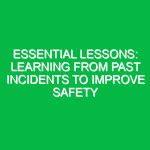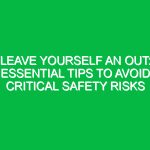“`html
Learning the Hard Way: Must-Know HSE Tips to Avoid Critical Mistakes
1. Introduction
Good morning team,
Today, we’re diving into a crucial topic that impacts not just our work environment but our overall well-being: Learning the Hard Way: Must-Know HSE Tips to Avoid Critical Mistakes.
In our line of work, safety is paramount. Understanding these essential Health, Safety, and Environment (HSE) tips can prevent accidents, promote a safer workplace, and ultimately save lives. Let’s explore why these tips are vital and how we can implement them in our daily operations.
2. Understanding HSE Tips
When we talk about HSE tips, we are referring to guidelines and practices aimed at preventing workplace accidents and health issues. These tips are designed to protect you, your coworkers, and the environment.
Many people underestimate the importance of following Safety protocols, believing that accidents won’t happen to them. However, a single oversight can lead to severe consequences, not just for the individual involved but for the entire team.
Let’s break down some common misconceptions:
- “It won’t happen to me”: Accidents can happen to anyone, regardless of experience.
- “Safety protocols are just guidelines”: These are essential rules designed to keep everyone safe.
- “I know what I’m doing”: Complacency can lead to critical mistakes.
3. Key Hazards, Risks, and Safety Considerations
Now that we understand the importance of HSE tips, let’s identify some specific Hazards and risks associated with our workplace:
- Slips, Trips, and Falls: These are common incidents that can result in serious injuries.
- Hazardous Materials: Improper handling of chemicals can lead to health risks.
- Equipment Mishaps: Failure to follow operational protocols can cause accidents.
Ignoring safety protocols can have real-world consequences, including injuries, lost workdays, and even fatalities. It’s critical to recognize these risks and take proactive steps to mitigate them.
4. Best Practices, Procedures, & Actionable Advice
To create a safer work environment, here are some Best Practices and Procedures to follow:
Step-by-Step Safety Procedures
- Conduct Regular Safety Training: Ensure all employees are trained in safety protocols and emergency procedures.
- Regular Inspections: Carry out routine checks on equipment and workspaces to identify potential hazards.
- Use Personal Protective Equipment (PPE): Always wear appropriate Safety Gear based on the task at hand.
Practical Tips and Real-Life Examples
For example, a construction site that implements daily safety briefings has seen a 30% reduction in accidents. This emphasizes the importance of communication and vigilance in our daily routines.
Another real-world incident involved a worker who ignored the need for Safety Goggles while handling chemicals. This oversight led to a severe eye injury, highlighting the necessity of following safety protocols.
5. Regulations, Standards, and Compliance
Compliance with Regulations is not just a legal requirement; it’s a moral obligation to protect our workforce. Key Standards include:
- Occupational Safety and Health Administration (OSHA) regulations
- International Organization for Standardization (ISO) standards
- Company-specific safety policies
Understanding these regulations helps ensure that we are all working within a safe framework. Remember, compliance protects not only you but also your colleagues.
6. Employee Engagement & Discussion
Now, I want to hear from you. What safety challenges have you encountered related to our practices? Have you ever experienced a near miss that made you rethink your approach to safety?
Feel free to share any tips or experiences that could benefit the team. Open discussion can lead to valuable insights and improvements in our safety culture.
7. Conclusion & Key Takeaways
To wrap up, let’s summarize the main points we’ve covered today:
- The importance of understanding and implementing HSE tips
- Identifying hazards and risks associated with our work
- Following Best Practices and safety procedures
- The necessity of compliance with regulations
Remember, prioritizing safety is not just a responsibility; it’s a commitment to ourselves and our colleagues. Let’s continue to make safety a priority every day.
Thank you all for your attention and dedication to maintaining a safe work environment!
“`


